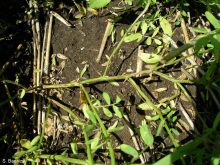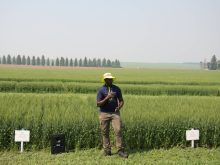Do deer defecate in the woods? Yes, and they also do it on other parts of the landscape. When they do, researchers want some of the material.
A study underway at the University of Calgary’s faculty of veterinary medicine is aimed at learning about gastro-intestinal parasite diversity in Alberta’s deer. Researchers intend to compare parasite loads in deer with those in sheep and see if deer play a role in transmitting drug resistant barber-pole worms to sheep flocks.
To do that, they need deer poop.
Read Also

Bunge’s crop mix is changing
Bunge has predominantly been a soybean processing firm, but that’s about to change after the merger with Viterra with softseed processing and grain merchandising gaining ground.
“We’re looking for one specific parasite. We’re looking to see the prevalence of that parasite within deer in Alberta, and eventually we’re hoping to extrapolate that … to (see) if the quantity of that parasite is higher in deer that are close to sheep flocks with the ultimate goal of seeing if these wild deer transmit this parasite between sheep flocks,” said U of C wildlife health technician Collin Letain.
“But right now we’re keeping it very broad focused. We’re just trying to get an idea of how prevalent this parasite is in deer right now.”
Hunting season is the ideal time to collect feces while field-dressing deer, said Letain.
That way samples are verified to be fresh and uncontaminated. Fresh road-killed deer are another potential source.
“The restriction we have is a fecal sample collected from someone who has visually seen a deer defecate,” Letain said.
“Another thing that’s been good for the month of November is if they have a hunting tag and they harvest the deer, they just collect feces from that.”
Eggs in feces die within 24 hours so visual verification followed by quick delivery to researchers is essential.
“What we’re trying to do is just get an idea of what parasites are in deer throughout the entire province, so we’re not being species specific right now, or age specific,” he said.
“We’re looking for any deer, white-tailed deer, mule deer of any age, any sex, anywhere in the province.”
The research project is funded through the former Alberta Livestock and Meat Agency, so samples are wanted from Alberta only, Letain said.
Research staff are working with doctors John Gilleard, Susan Kutz and Michel Levy.
There is no risk to humans in the collection of deer feces, although gloves are recommended.
At least 30 pellets are required in a sample, and they should be placed in a Ziploc sandwich bag with as much air squeezed from the bag as possible. Double bag the sample and include specifics on where it was collected and, if known, the species, gender and approximate age of the deer involved.
Samples should not be frozen and should be shipped by courier early in the week so they don’t sit over a weekend.
“We’ll take whatever we can get,” said Letain.
“Essentially whatever they’re willing to offer is what we’re willing to have.”
Further details are available from Letain at 403-210-6678 or by email at cletain@cwhc-rcsf.ca.
The shipping address for samples is:
Dr. Susan Kutz/Collin Letain
Faculty of Veterinary Medicine, University of Calgary
HSC 2535, 3280 Hospital Drive NW
Calgary, Alta. T2N 4Z6
Contact barb.glen@producer.com
















